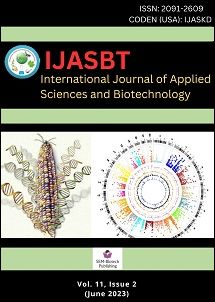Bacteriological Profile and Detection of β-Lactamase Producing Bacteria Isolated from Blood Samples of Neonates
DOI:
https://doi.org/10.3126/ijasbt.v11i2.56116Keywords:
Neonatal sepsis, ESBL, MBL, Antibiotic Resistance, KPCAbstract
The clinical impact of β-lactamase has become a public health problem around the world in terms of increased morbidity and mortality, especially in the child population. This study was aimed at determining the bacteriological profile and detection of β-lactamase producing bacteria isolated from the blood samples of neonates. For this study, a total of 1335 blood samples of neonates admitted in NICU, SCBU, and sepsis-suspected neonates visiting Paropakar Maternity and Women’s Hospital, Thapathali, Kathmandu, Nepal were collected and processed. Blood culture was performed and the identification of bacteria was done by following standard microbiological methods. Antibiotic susceptibility testing was done by using the Kirby Bauer Disk Diffusion method and confirmation of ESBL, MBL, and KPC-producing bacteria was done by Combined Disk Test. The prevalence rate of neonatal sepsis was found to be 17%. K. pneumoniae 116 (50.2%) was the predominant Gram-negative bacteria followed by K. oxytoca 31 (13.4%) whereas S. aureus 39 (16.9%) was the predominant Gram-positive bacteria causing neonatal sepsis. Among 182 Gram-negative bacterial isolates, 69 (37.9%), 22 (12.1%), and 14(31.1%) were found to be ESBL, MBL, and KPC producers respectively. K. oxytoca (54.8%), Enterobacter spp. (25%) and Citrobacter spp. (14.3%) were the predominant ESBL, MBL, and KPC producers respectively. The co-production of ESBL, MBL, and KPC was also found among the 5 Gram-negative bacteria. Colistin, Meropenem, and Imipenem seem to be the choice of the drug against Gram-negative bacteria, whereas Vancomycin and Cefoxitin seem to be the choice of the drug against Gram-positive bacteria. Therefore, to lessen the burden of antibiotic resistance, it is essential to conduct regular antimicrobial susceptibility surveillance, periodic reviews of hospital settings, and early detection of beta-lactamase-producing bacteria.
Int. J. Appl. Sci. Biotechnol. Vol 11(2): 66-77.
Downloads
Downloads
Published
How to Cite
Issue
Section
License
Copyright (c) 2023 International Journal of Applied Sciences and Biotechnology

This work is licensed under a Creative Commons Attribution-NonCommercial 4.0 International License.




